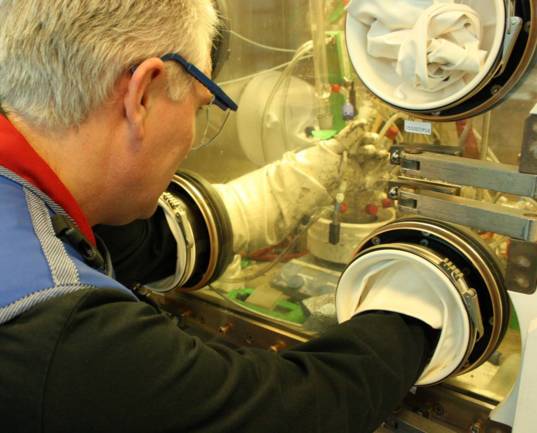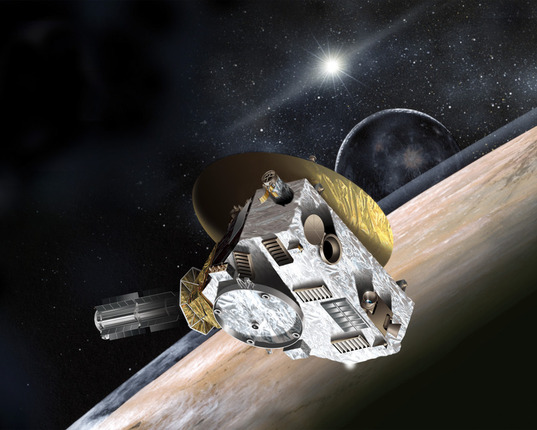.
As a child of the 1970s, I grew up on my fair share of science fiction. Movies and TV shows like Star Trek and Dark Star, along with books by authors like Isaac Asimov or George O. Smith fueled my imagination. These all depicted space as, whilst hostile, a rebellious new frontier where humans could live, work and maybe play: the Wild West, but without Monument Valley. The reality is very different. Space is cold, lonely, and incredibility hostile to humans. The distances we must travel to get anywhere are truly mind-blowing. Take NASA's New Horizons, for example. On July 14, 2015, it will make its fly by of Pluto and its moon Charon. Launched in January 2006, it has taken 10 years and travelled 5 billion kilometers to get there. It will pass by the dwarf planet in a matter of minutes, spending the next 18 months transmitting the data it has captured. Voyager 1 is another example. Launched when I was still in short trousers, it is 18 billion kilometers from earth and still phoning home. Closer to home, Mars Science Laboratory trundles around the planet Mars shooting laser beams at rocks and drilling into the ground.
These spacecraft all demonstrate the ingenuity, innovation, and pioneering spirit of humanity. They also share the same power source at their hearts, providing the heat and power that are so essential in the cold, dark vacuum of space. Each derives its power from a few kilograms of red-hot plutonium-238. Without it, the spacecraft would not survive. Solar energy is too weak. The heat from the plutonium is able to keep essential systems warm and to also be converted to electricity using the thermoelectric Seebeck effect. With a half-life of 87.7 years, the plutonium has the potential to provide heat and electricity for well over a century.
.

10 W RTG
Model of a 10 W RTG system developed by University of Leicester and Airbus Defence and Space.
However, making plutonium-238 is expensive and difficult. You need a reactor with the right neutron flux and a supply of neptunium-237 feedstock to produce the plutonium. You also need a small nuclear reprocessing plant to separate the plutonium chemically from the highly radioactive fuel. Over the years, plutonium-238 has been produced by a number of countries including the USA, Russia, and the UK. Historically, some material has even been used to provide the electrical power in heart pacemakers.
In the case of plutonium for space applications, stocks of the material are now running low. The USA is restarting production, but the current stocks and production rate in the near term are unlikely to be high enough to support the broad range of space missions that the US science community might wish to target. In Europe, without the neptunium-237 feedstock and necessary processing facilities, the production of plutonium-238 is considered too expensive. As a consequence, Europe has decided to focus on an accessible alternative material that could power future spacecraft: americium-241. This isotope - in very small 1 microcurie quantities - provides the ionizing alpha radiation that makes smoke detectors in all our homes work. In larger quantities, this same alpha radiation generates heat in a similar way to plutonium-238.
A member of the transuranic series, americium is a waste produced when uranium nuclear fuel is irradiated by neutrons in a reactor. A ton of used nuclear fuel can contain 100 grams of americium. It is possible to extract the americium from used nuclear fuel, but it is difficult, expensive, and has a relatively low yield. The other big problem is that this americium is not pure americium-241; it contains many other isotopes of americium, rendering this route for the production of americium-241 unsuitable.
An alternative route is to exploit the beta decay of plutonium-241. When nuclear fuel is reprocessed, the plutonium is separated from the uranium and fission products and stored for reuse as fuel in civil nuclear reactors. Nuclear fuel that has been in a civil reactor will contain a range of plutonium isotopes including 241, which has a decay half-life of 14 years to americium-241. The long-term storage of civil-separated plutonium will therefore produce very isotopically pure americium-241 via this beta decay. Like the americium in used nuclear fuel, this americium is also considered by the nuclear industry to be a waste product that needs to be removed before the plutonium can be reused in nuclear fuel. In the UK, more than 100 tons of plutonium have been separated and stored, some for several decades, resulting in a potentially plentiful and reliable source of americium-241 that would otherwise be disposed of as waste. This americium-241 can be harvested from the stored plutonium by using a relatively simple chemical and a cost effective process that does not require working with highly radioactive used nuclear fuel.
Compared to plutonium-238, which has a half-life of 87.7 years and heat output of 0.4 watts per gram, americium-241 lasts longer with a half-life of 432 years but has a lower heat output of 0.1 watts per gram. The longer half-life means that the heat, and therefore the power output, reduce more slowly through time when compared to systems of equal power output. In addition, the higher isotopic purity of the americium-241 (greater than 99%) partially compensates for the reduced heat and power output. At present the European programme has focused on developing scalable Radioisotope Thermoelectric Generators (RTGs) in the 10- to 50-watt electrical power range and with a specific power of between 1 and 2 watts per kilogram. For comparison, current plutonium-238 based RTGs produce roughly 120 watts with a specific power of approximately 3 watts per kilogram.
.

Am-241 separation
Separation of americium-241 in the gloveboxes at the National Nuclear Laboratory.
Americium-241 is also well-suited to heat-only systems such as Radioisotope Heater Units (RHU). In these systems, the lower power density of americium is less important, making americium an attractive option. These units also offer the possibility of very small, sub-watt RTGs, where energy harvesting using thermoelectric conversion offers an attractive option for low-cost or small missions. Small amounts of electrical power combined with heat sources could open a range of new mission scenarios. Modern chemical batteries, protected from freezing due to the cold of space by the heat source, would be continuously trickle-charged by the RTG unit, providing usable power for small spacecraft such as landers or CubeSats. Waste heat could also be used for thermal management.
Developments in Europe are progressing rapidly. From a standing start in 2009, the European Space Agency has funded a programme of development that has established the ability to produce americium-241 and make test pellets, developed and tested a laboratory prototype for a 5-watt electric RTG, and developed new thermoelectric generators suitable for the temperature range of americium-241. The program is also currently developing Stirling engine conversion as a potentially more efficient conversion system and is exploring future potential RHU designs. The area of launch safety and its requirements is also a key element of all parts of the program of work. The next year or two will see further advances towards advancing the maturity of key technologies and the radiogenic heat conversion systems as well as consolidating RTG designs. As with everything in the modern world, success will be very much dependent on continued funding. Assuming that the funding is sustained, a fully developed launch-ready americium-based nuclear-power source would require a further decade of development, a typical time frame for an ambitious space technology program. Continued sustained support and successful progress could result in launch-ready americium RHUs in the mid 2020s, and RTGs soon after. Given the plentiful availability and cost-effective production of americium-241 compared to plutonium-238, European RTGs and RHUs have the potential to be a very cost-effective and reliable source of heat and electrical power for a wide range of future space missions.
.

New Horizons at Pluto, July 2015
Artist's concept of New Horizons as it reaches Pluto.
When New Horizons waves goodbye to Pluto and starts its journey exploring the Kuipler belt, there will remain many unexplored places in the solar system. Submarines exploring Titan, spacecraft in orbit around Uranus, or balloons floating in the atmosphere of Venus are achievable yet challenging goals that lie in our future. European americium-241 has the very real potential to be a key enabling technology for the next generation of pioneering spacecraft that will delve deeper into the solar system.
Quelle: The Planetary Society
4832 Views
